The cake market is an ever-moving feast of deliciousness – from punchy flavours to buttercream-laden creations. Here, British Baker explores the trends taking hold of the market in 2023.
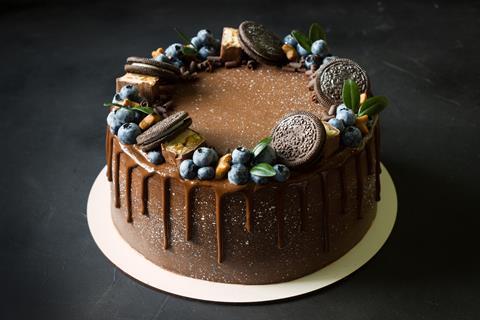
Take a trip to flavour town
Away from the stalwarts of chocolate and vanilla, flavours change quickly in cake land. Often changing seasonally, they can signal indulgence, health, and premiumisation among other things.
American-inspired flavours are still a firm favourite when it comes to cakes, with toasted s’mores and salted caramel noted by Daryl Newlands, head of brands & marketing at Finsbury Food Group. Cookies and cream is another American classic proving popular, according to The Hummingbird Bakery, which offers the flavour for its cupcakes and cheesecakes.
The arrival of autumn has seen pumpkin spice hit the scene, with Patisserie Valerie one of the brands to bring this to life in the form of a Pumpkin Spice Latte Cake. The cake is layered with pumpkin, coffee and cinnamon cream cheese and adorned with caramel flicks, chocolate plaques and a fiery design the colour of autumn leaves.

Cake manufacturer BBF is also predicting an interest in spiced and richer flavours as the weather cools with the likes of sticky toffee and ginger cropping up. Spices such as cinnamon and cardamom will also be integrated along with honey and orange.
“Tastes are expanding with customers who want more variety and fun options such as pumpkin spiced latte, toffee apple, pistachio, lemon & blueberry, salted caramel, and key lime flavours,” says Patisserie Valerie development chef Anna Rugen. “Traditional sponges such as vanilla or chocolate can be enhanced by incorporating the flavours into the external cake designs or buttercream. We have seen everything from cookie dough, Oreos, Lotus Biscoff, pretzels, and doughnuts.”
From America to Australia – flavours from down under are also anticipated to win over cake lovers.
“Native Australian ingredients are something completely new in the UK bakery sector and we are predicting they will be big news going forward,” says Olivier Briault, pastry chef and development chef at Maple from Canada UK, highlighting saltbush, wattleseed and myrtle as useful ingredients.
“Full of nutrients, wattleseed can be ground and added to bakes, while lemon myrtle, which is endemic to the rainforests of Queensland, can be added to cheesecakes and trifles as well as cakes, to give a contemporary twist to lemon drizzle for example,” he notes.
Saltbush, meanwhile, appeals to the nation’s continued love of sweet and salty combinations and pairs well with caramel, chocolate and mango or raspberries, Briault adds.
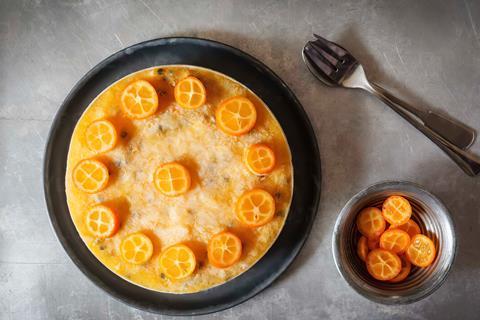
“There is still a connection with customers and the outdoors so foraged and wild flavours such as rosemary, sorrel, elderflower, and orange blossom are popular too,” adds Jonathan Moore, Asda’s senior director of culinary innovation. “Sour has grown in popularity too including flavours such as rhubarb, sea buckthorn, yuzu, sumo orange and kumquat.”
He notes umami flavours such as miso are also gaining traction, particularly when used in caramel.
The latter taps into continued interest in Asian flavours and spices traditionally used in savoury products, as highlighted by Kitty Glencross from University College Birmingham – one of Dawn Foods’ new student ambassadors for next year. “Younger consumers are seeking new twists on the classics or something completely new,” she says. “New flavour influences include calamansi (citrus), kumquat and Japanese ones, such as yuzu and sakura (cherry blossom).”
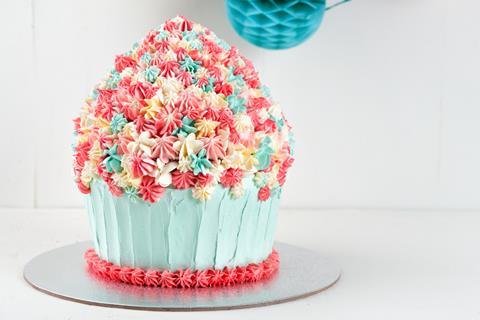
More is more
When it comes to decoration, more is more, according to Patisserie Valerie’s Anna Rugen.
“Many showstopper and ‘Instagram’ cakes have a variety of elements to create multiple points of interest, combining a mixture of stencils, metallics, piping, drips, flowers, and edible and non-edible decorations such as sprinkles, macarons, fans, and personalised toppers,” she says.
For those on social media, buttercream is the covering of choice as Janine Pope, marketing communications manager at Renshaw notes buttercream piping and painting is appearing more frequently - driven by nostalgia and the ‘wow’ factor. Kitsch cakes, which Pope describes as “hugely on trend”, also tap into this with elaborate piping, bright colours, and fruit decoration – all of which was seen in the run-up to the platinum jubilee.
“Cakes that showcase a variety of piping techniques, such as intricate Lambeth piping, buttercream flowers, rosettes, shells, and written messages are perfect for vintage-style cakes and cupcakes – ideal for individual treating or gifting – and are bang on trend,” adds UCB’s Kitty Glencross.
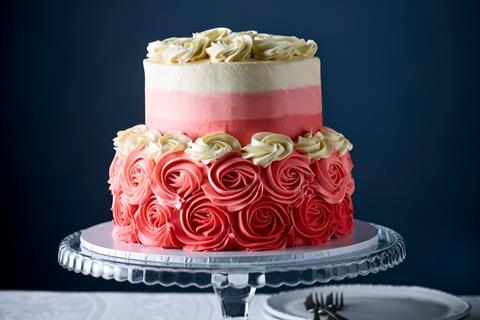
Besides being stunning, these overloaded and intricate cakes have another benefit, according to BBF CEO Jonathan Lill. “Overloaded bakes are, as the name suggests, overloaded with toppings to not only make them more aesthetically pleasing, but to also give value for money appeal, which consumers will be prioritising as the cost of living continues to increase,” he says.
At the other end of the spectrum there is still demand for sleek, minimalist designs featuring smooth buttercream, neutral colours and tasteful yet effective toppings.
“We will see this being stripped back to the bare minimum, using almost clear icings to expose the wonderful texture underneath – especially with cake flavours like lemon & poppyseed or carrot,” believes Karolina Glowacka, new product developer at hamper and cake brand, Cartwright & Butler.
Both styles are evident in Patisserie Valerie’s celebration cake range, which it unveiled earlier this year, from the colourful buttercream-laden Ombre Rosette Cake showcasing hand-piped roses to the minimalist Naked Blossom Cake with delicate sugar flowers on top.
“We expect to see more floral designs and anticipate the drip cake to be around for some time,” adds Rugen. “Many cake designs are akin to edible pieces of art and decoration is everything.”
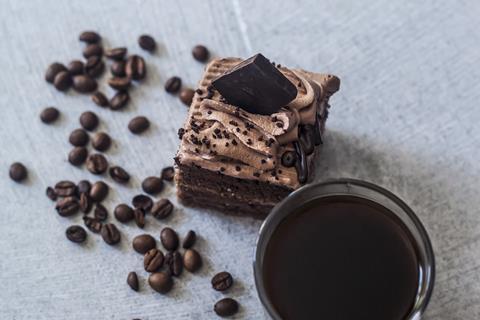
Everyday comforts
While towering tiered creations are driving consumers wild on special occasions, many predict small but indulgent treats will find favour with those looking for everyday comfort.
“With the increasing cost of living, we expect people to be spending less on a day-to-day basis on sweet treats in 2023, with snacking products being favoured over extravagant cakes,” says Jonathan Lill, BBF CEO. “Although celebration cakes will remain important for special occasions, we expect there to be a trend in people looking for cakes that give them added value for money.”
That doesn’t mean indulgence and innovation is off the table. If anything, there’s more room for it.
“People are finding fun moments where they can, and food is always front and centre,” says Asda senior director of culinary innovation Jonathan Moore. “This means there are no rules so we can shake off any traditions when it comes to different formats, flavours and pairings and just go for it.”
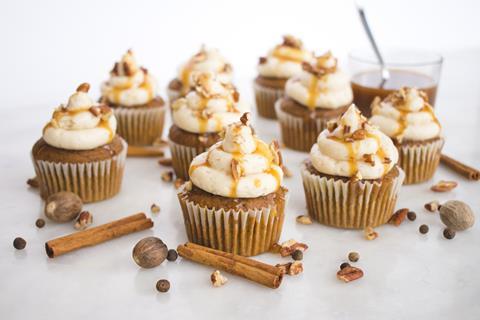
It is here that many of the flavour trends come into their own, as Newlands at Finsbury Food Group adds that “trends tend to be executed more through visual within celebration cakes whilst sharing and snacking is delivered through flavour, texture and more simplistic finishes”.
Janine Pope at Renshaw concurs: “An everyday cake will usually focus more on what’s within the bake or the fillings, for example a gooey caramel centre or layer of marzipan to make a chocolate slice pop. That doesn’t mean the appearance is not important but you’re more likely to see a quick spray of gold lustre or sprinkle of glitter, than fondant shapes and elaborate piping.”
Decorations supplier Truly UK notes a big rise in the sale of its 100s and 1000s mixes as more bakers opt to use sprinkles for smaller, more impactful bite-sized treats.
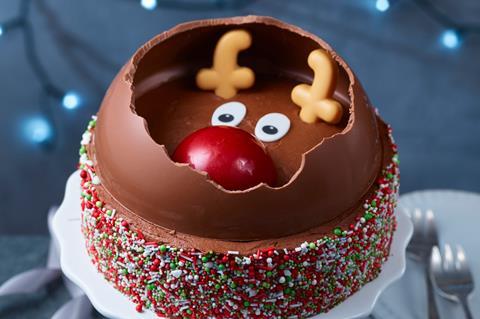
Throw some shapes
“A big trend this year has been unusual, shaped statement cakes,” says Pope. “Domes in particular seem to have taken social media by storm, whether this is an igloo shape, or more of an arch.”
These can already be found outside of the British Isles with the likes of Swedish princess cake, Italian zuccotto cake, made with ice cream and sponge, and baked Alaska featuring prominent domes.
Dome cakes, specifically smash dome cakes, have proven popular among the festive ranges this year with Aldi unveiling one as well as Asda. Both chocolately creations feature a chocolate dome designed to be smashed to reveal a surprise inside.
Taking this trend even further are illusion cakes which have won over users on social media as they guess ‘is it cake?’ Sainsbury’s has even utilised this strategy for its sponsorship of Bake Off. “It is all about the attention to detail and clever use of fondant that makes them so special,” adds Pope.
ADVERTISEMENT: RENSHAW
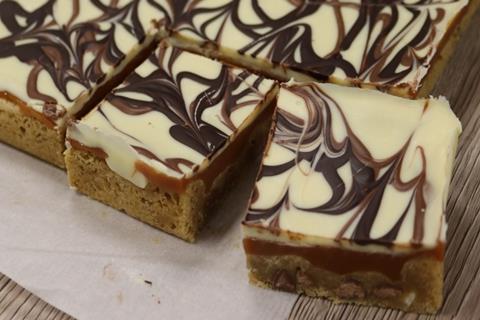
Recipe: Caramel Cookie Bars
Ingredients - Makes one 8x8” tin
- 412g plain flour
- 6g bicarbonate of soda
- 2g salt
- 11g corn flour
- 172g butter
- 82g granulated sugar
- 202g soft brown sugar
- 2 eggs
- 6g vanilla extract
- 150g white chocolate chips
- 150g milk chocolate chips
- 150g dark chocolate chips
- 400g Renshaw Baking Caramel
- 350g white chocolate
- 200g milk chocolate
- 200g dark chocolate
You will also need two piping bags and a cocktail stick.
Cookie base method
- Pre-heat oven 190/165C fan assisted oven, line the tin with parchment paper
- Add flour, bicarbonate of soda and cornflour to a bowl and mix
- Melt the butter in a pan or in the microwave, until the butter is at boiling point, then add the granulated sugar, soft brown sugar and mix until sugar has dissolved. Allow to cool slightly and add the egg and vanilla extract mix again
- Now add the dry ingredients to the butter/ sugar mix. Mix with a spoon, it will soon start to resemble a cookie dough
- Blend in the chocolate chips and mix again
- Allow the base to cool, this can then be rolled out to the size of the tin. Place inside the tin, making sure it’s a level surface
- Bake in the oven 15-23 minutes. It should be a pale brown colour, baking for tOo long will, will dry the base. Allow to cool.
Filling
- Heat the baking caramel in the microwave. Remove lid and place microwave on full power, for 10 seconds. Stir and heat for another 10 seconds. Until the caramel is a spreadable consistency. Alternatively use a bain marie, stirring until a spreadable consistency is achieved is reached. Allow to cool.
Decoration
- In separate bowls melt the white, dark and milk chocolate
- Add the white chocolate and spread on the surface to cover the baking caramel, add the milk and dark chocolate to piping bags
- Quickly pipe both chocolates in random patterns on the white chocolate, then use the cocktail stick to create a marbled design
- Allow the chocolate to set, cut into required size pieces.




















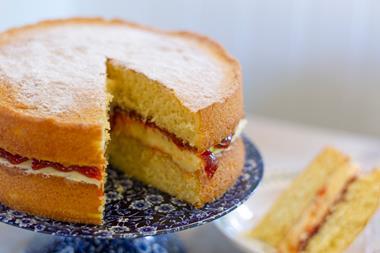
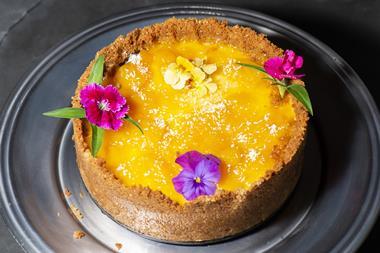
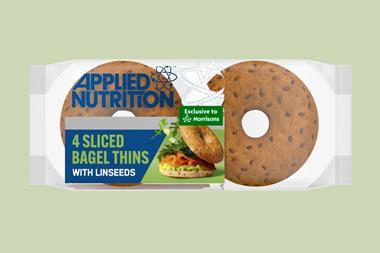





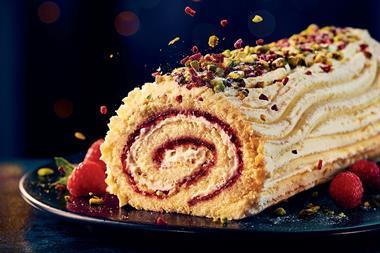

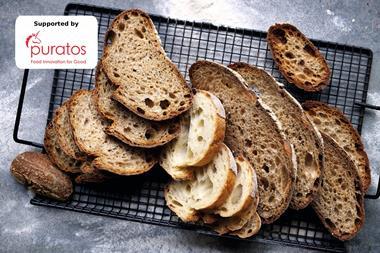


No comments yet